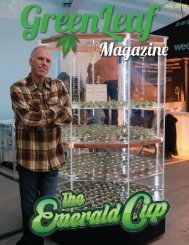September 2016 Issue
Create successful ePaper yourself
Turn your PDF publications into a flip-book with our unique Google optimized e-Paper software.
Ice Water Sieving<br />
by Frenchy Cannoli<br />
Hashish is a psychoactive drug made from sieving<br />
the resin glands from the dried and cured Cannabis<br />
flowers, which is then pressed into a resin mass using<br />
a source of heat.<br />
Traditional Hashish producing methods protect the<br />
wholeness of the trichomes, which house the full<br />
psychoactive and medicinal potential of the plant.<br />
Hashish is not only the repository of the wholeness of<br />
the plant but this ancient methodology creates over<br />
fifty new and rare compounds during the transformation<br />
that can be traced to the live and dried plant.<br />
Producing traditional Hashish is like making wine,<br />
collecting the ripest fruit is only the first step of a<br />
transformation towards excellence.<br />
A Hashishin is a craftsperson, and as such needs to<br />
have a deep knowledge of all aspects of the substance<br />
they work with. Learning the science behind the<br />
formation and development of the terpenes and<br />
cannabinoids inside the trichomes will help to master<br />
the craft but more importantly leads to appreciation<br />
of the magic of this unique gift from Mother Nature.<br />
The resin we collect is the bibliography of the plant’s<br />
life, the Book of the Hashishin.<br />
A craftsperson’s mastery of their art is also determined<br />
by the tools they use, in our case we use a<br />
sieve, which is “a device with meshes or perforations<br />
through which finer particles of a mixture (as of<br />
ashes, flour, or sand) of various sizes may be passed<br />
to separate them from coarser ones…”. The definition<br />
of the word clearly implies that the sieve has to be<br />
absolutely clean at all times, the process of separation<br />
simply cannot happen when the perforations<br />
that form the sieve are blocked. Less obvious, but as<br />
important, is the ratio of raw material to<br />
sieving surface. Working with a small<br />
quantity of material on a large sieving<br />
surface is much more efficient than<br />
working with a huge pile of material on a limited<br />
sieving surface.<br />
Hashishins the world over hunt the “melt” which is<br />
expressed by the amount of resin formed in the resin<br />
heads. We seek perfect ripeness and maturity, as well<br />
as purity, meaning the cleanliness of the trichomes<br />
collected.<br />
In producing countries, the quality of dry-sieved<br />
resin is largely determined by purity, contaminants<br />
are unavoidable when working with dry and brittle<br />
material; the more force applied to the handling of<br />
the material the more impurities will be created. Trichomes<br />
have a tendency to fall easily, little agitation<br />
is initially necessary to break the resin heads from<br />
their stalks but the process needs to be repeated a few<br />
times, with more force applied with each subsequent<br />
agitation in order to collect the majority of trichomes<br />
from the plant matter. Quality, in producing countries,<br />
is mostly dictated by purity and not maturity.<br />
Dry sieving is made up of two inseparable processes;<br />
the agitation of the material and the separation of the<br />
falling matter through the meshes of the sieve. The<br />
incorporation of water into this equation is a game<br />
changer.<br />
By using water we have the ability to rehydrate brittle<br />
material beforehand and work with plant matter that<br />
has fully regained its suppleness. The obvious benefit<br />
is to limit contamination of the resin by broken leaf<br />
matter but more importantly, the sieving process<br />
becomes two separate steps - 1. Agitation in the machine<br />
and 2. Separation (sieving) in the bags.<br />
Water gives us the ability to agitate and separate optimally<br />
without contaminating the purity of the resin.<br />
We can now focus on the most important aspect of<br />
resin quality, seeking the ultimate ripeness of the<br />
resin heads, the perfect melt.<br />
The following sieving bags sizes, measured in microns,<br />
are available on the market; 220, 190, 160, 120,<br />
90, 73, 45, 25. Each bag size represents a slice of the<br />
plant’s cannabinoid and terpene spectrum.<br />
The vast majority of modern Hashishins hunt the<br />
melt by the size of the trichomes; the smaller resin<br />
heads range in the 25-micron size while the largest<br />
can be from 220 micron up to 500 micron. It is<br />
impossible to separate adequately resin and contaminants<br />
in the 25-micron and the 160-micron bags<br />
because trichomes and impurities are similar in size<br />
and cannot be separated by sieving.<br />
The industry recognizes the optimal size of mature<br />
trichomes in a range from 45 microns to 120 microns,<br />
73 microns to 90 microns offering the best results. It<br />
is important to note that the ideal size of trichome<br />
development is dependent on the plant’s genetics as<br />
well. Generally speaking, a Sativa dominant strain<br />
will have smaller resin heads than an Indica dominant,<br />
which makes the evaluation of optimal melt by<br />
tricomes size problematic.<br />
I would not trade the wholeness of what I call “full<br />
spectrum” Hashish (sieved together using 45 to 160<br />
micron bags) for a concentrate that represents just<br />
a single slice of the spectrum, however “full melt” t<br />
resulting resin may be. The melt is an important<br />
element when evaluating quality but there is more<br />
t than just the visual pleasure when experiencing<br />
c cannabis resin. It is after all a gustatory experience<br />
a snd should be approached as such.<br />
J26







